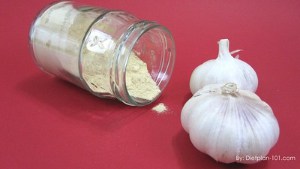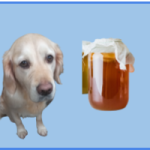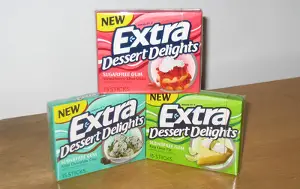Dating back 5000 years, garlic is one of the oldest known foods.
In the way that it can add heaps of flavour to the simplest meals, it is little wonder why it is so popular worldwide.
In 2004, it was estimated that the equivalent of 2.4 lbs of garlic was eaten by every person in the US.
The US grows about four hundred million pounds annually.
Which might sound a lot but not when you consider that China produces about twenty two million tonnes annually.
And what is interesting in an article about garlic powder is that 75% of all garlic eaten is dehydrated.
Which isn’t surprising in the busy and hectic world that we live in.
Garlic powder is great for us, but what about for our dogs?
To start, I’m going to provide a very quick answer to your question before delving deeper into the topic.
Can dogs eat garlic powder?
Your dog can eat garlic powder.
Using very small amounts to add flavour to a bowl of dog food or for medicinal purposes probably won’t harm your dog but it might not help them either.
But that is a whole ‘nother story.
The trouble with garlic, in any known form, is that it is a toxin for dogs.
If too much of it is consumed by a dog, it might poison them or even kill them.
As always this depends on the amount of garlic that your dog has eaten compared to how much they weigh.
But for most dogs the amount of garlic that they would need to consume would be massive.
But even so, if you know that it might harm your dog, why would you want to risk using it?
Let me give you some more details on all of this…
What is garlic powder?
Garlic powder is made using 100% garlic.
It is important to know the percentage of garlic used in garlic powder because that will help us to decide if it is toxic for our dogs or not.
And without carrying out a bit of research on the topic, garlic powder might have contained other ingredients apart from garlic.
I don’t know if, by having to do the result, it makes me look like a fool or merely extremely cautious!
Fresh garlic is peeled, dried (or heated) and then chopped, ground or minced until the particles are the correct size.
Garlic powder vs fresh garlic
Let’s face it, if we can make things easier and quicker for ourselves in the modern world then we will.
And garlic powder is just one small example of that convenience.
Fresh garlic is a huge faff, don’t you think?
The peeling, the crushings and the chopping- not to mention the clearing up.
I mean, who wouldn’t want to use a jar of powder?
It is a much faster way to use garlic, with much less mess.
An, from what I can see, a jar of garlic powder will last up to two years before it becomes stale.
Other forms of garlic
Similar products to garlic powder are of course available, which isn’t a surprise when you think of how popular a product it is and how much is consumed.
These include garlic granules and chopped granules.
These are just fresh garlic chopped up in a glass jar
And these hydrated products are better for people who believe that garlic powder doesn’t have the potency or the strength of fresh garlic.
Using garlic with dogs
For most of us garlic is used to flavour our food.
For some of us the smell of garlic being fried in a pan is a feast for the nostrils.
To others, not so much!
And a common use of garlic powder with dogs seems to be as a garnish for dog food.
A means of spicing up that dull bowl of kibble or a way of tempting that picky eater to eat more.
But the powers of this lowly plant, go way beyond what it adds to our food.
Garlic is a widely used home remedy for dogs– used to prevent everything from fleas and ticks to help with blood pressure or to bolster a weak immune system.
And it has many powerful health benefits for people as well- uses that go back many thousands of years.
Is garlic toxic to dogs?
Garlic is unfortunately toxic to dogs.
It is one of those rare foods that are totally harmless to people (if you don’t count “garlic” breath) but could be dangerous to dogs.
It contains a substance called thiosulphate which a dog’s body cannot process and therefore it becomes like a poison.
It triggers a reaction of haemoglobin to form clumps which can lead to red blood cells being destroyed.
If enough thiosulphate is consumed and enough red blood cells destroyed, a dog can be starved of oxygen and will die.
It isn’t just garlic
Garlic is one member of a vegetable family all of which are poisonous to dogs.
The other members of the allium include onions, shallots, leeks and cloves.
And apparently the levels of thiosulphate are much higher in garlic than the other members of the family..
How much garlic powder can kill a dog?
There are two ways to work this out.
Firstly, you can use the rough guide of between 15- 30g of garlic per kilogram of a dog’s body weight could lead to a toxic reaction.
And so for my 30 kg Golden Retriever would need to consume at least 450g of garlic which might mean eating as many as 90 garlic gloves.
How many jars of garlic powder would that be?
Or another way to calculate it is that a dog shouldn’t consume over .5% of their body weight.
If that makes it any easier.
It also gives a much lower limit for the amount of garlic that should be eaten.
For my 30 kg dog, .5% of their weight is 150 g.
So they shouldn’t consume more than 150 g of fresh garlic or garlic powder.
It is very confusing when the numbers can vary so much (450 g vs 150 g) and that the numbers seem so high.
Even 150 g of garlic is a huge amount of garlic, a colossal amount of garlic powder.
But if you have a Chihuahua, weighing in at just 3kg, then the threat is much greater and the amount of garlic or onion that needs to be consumed, much, much less.
More concerns about garlic
Another important thing to remember in this discussion is that not every dog will react in the same way to thiosulphate poisoning.
And some dogs will be more vulnerable.
Dogs to watch out for include puppies who haven’t developed fully yet and older dogs whose bodies don’t work as efficiently.
And dogs with pre existing conditions.
Since thiosulphate poisoning targets the blood any dog with a known blood disorder could be at increased risk as well.
How fast is garlic poisoning?
Something that I have yet to explain is that thiosulphate toxicity can happen as a result of a one off event or as a part of a process that happens over several days.
Let me explain.
Your dog could be in danger of being poisoned by eating too much garlic at one meal or over one day or even over a week.
For instance, if you have just started to add garlic to your dog’s meals as a natural flea treatment, then the garlic that you have added to one meal is unlikely to do them any harm.
But over the space of a few days, as you continue to feed them garlic, the toxins will increase in their body and as a result of all of that garlic a week later your dog might get sick.
What are the symptoms of garlic poisoning?
If your dog has been poisoned by all the garlic that they have eaten, then there are some key behaviours that you need to look out for.
Just as it is for humans, smelly breath is a telltale sign that your dog has had too much garlic.
Other symptoms include: red or pink urine, increased heart rate, lots of panting, pale gums and vomiting and diarrhea.
If you do see your dog displaying any of these symptoms then you should phone your vet as soon as possible explaining that you think that the cause of it is because they have eaten garlic.
An alternative option for you is to phone the Pet Poison Helpline.
Now, these people are the poison experts and they are available 24/7.
You will pay a $65 fee for any advice that they give.
Garlic powder alternatives
If you are using garlic powder to spice up a bowl of dull kibble or to tempt a picky eater to eat more food, I want to suggest a safer alternative to you.
And, don’t worry, I’m not going to recommend swapping out garlic powder for ginger powder or anything strange like that.
My alternative will be guaranteed to be a very tasty, healthy alternative that will attract the most reluctant eaters.
And with zero chance of poisoning.
It is making bone broth to add to your dog’s food.
I grant you- it is much more involved than sprinkling powder onto food.
But the recipe is very simple, it is how long that it needs to cook for that is the kicker.
Is garlic powder toxic to our dogs? An alternative view
Most of the information that I have presented in this article comes from a majority view which is don’t feed your dog garlic in any form.
But there are experienced people out there who think that garlic is safe to use with your dogs.
And that the warnings and studies that indicate that garlic might be toxic are wrong.
And I’m not talking about weird conspiracy theorists, I’m talking about established vets.
One of them is Dr Lisa Newman who has written an article explaining why most animal professionals are wrong about the apparent dangers that garlic poses to dogs.
It is a thought provoking and very well written piece.






